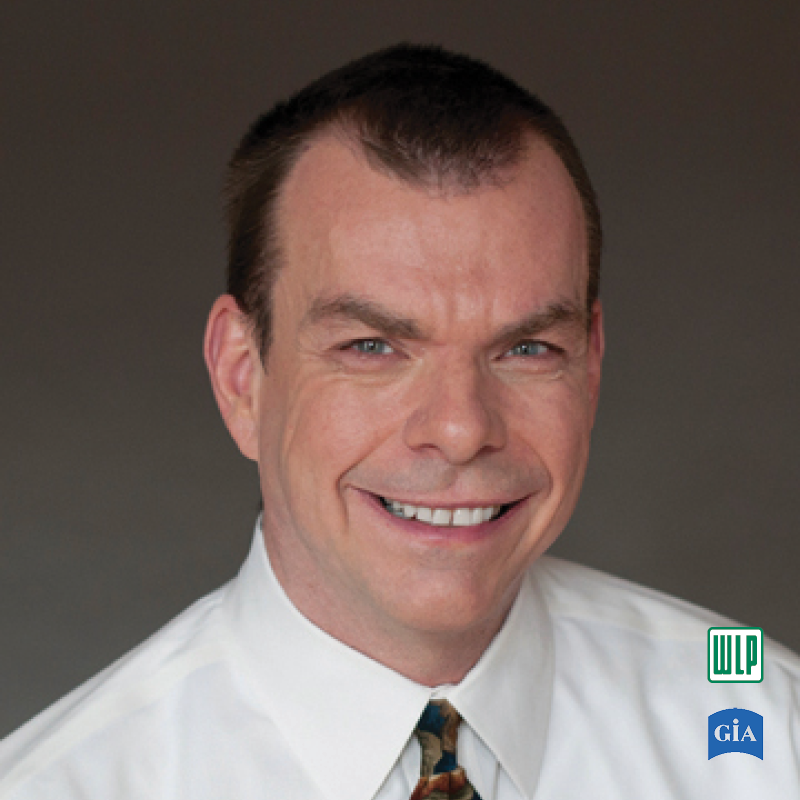Listening with God’s Ears:
Rethinking the “Lowest Common Denominator”
BY Alan Hommerding
“There is no sound more beautiful than people singing God’s praise!”
If there is one maxim that continues to be the bedrock of my life as a liturgical musician, this is it. My first choir director/organ teacher, Ann Celeen Dohms (who later became a colleague and friend, always a mentor), said it often. I recall it as far back as boychoir in third grade, and Ann Celeen continued to use it through my junior high and high school years of organ study with her.
As you might expect, when you seat a teenage boy at a pipe organ, restraint and subtlety are not going to come instinctively. While she did give me opportunities to open up the organ’s lungs, when it came to accompanying the congregation, choir, or cantor, I was often curtailed. Though I don’t recall her using the word “never,” it was implied in any sentence that began with “Oh, honey.” (“Oh, honey, that’s too many stops for playing a hymn.”)
I’ve often referred to her as my musical Auntie Mame because she had a continual zest and enthusiasm for life and music. The zest was nowhere more evident than when she was talking about people singing God’s praise. I was fortunate to grow up in a parish that sang robustly. Being of Germanic/Low Country heritage, we had hymn singing in our bones for centuries before the Second Vatican Council. (This contributed to my mystification later in life when I heard liturgical scholars say that hymns weren’t part of the Roman rite.) The usual jokes about the Catholics taking a back seat to the Protestants in the singing arena was certainly not my experience growing up.
Fast forward
Decades later, with pastoral experience and additional musical and liturgical education under my belt, I find Ann Celeen’s maxim still resonating, and it still serves as my own first principle. This is, no doubt, what causes me to bristle when one of my musical colleagues gripes about the pastor wanting a congregational song at such and such a spot in the liturgy rather than a choir anthem.
One time, when somebody complained on social media about having to use a congregational song and called it a case of the clergy always going for the “lowest common denominator,” I replied: “Let’s please stop using the term ‘lowest common denominator’ to refer to music written for and sung by the assembly. Music that is well-crafted and within the musical abilities of the assembly is no higher or lower than a Palestrina motet. Yes, some terrible music has been written for and continues to be used for the assembly. But there’s plenty of choral dreck around too—assembly music hasn’t had the benefit of centuries of winnowing to sort it all out.”
Clearly, I have yet to learn the lesson that once you post something on social media, it doesn’t go away, and your precise words can come back to haunt you forever and ever, world without end. In this particular instance, however, it’s a happy haunting, since I truly and firmly believe the response that I wrote.
Not lower or higher
Though the “Constitution on the Sacred Liturgy” (CSL) uses terminology such as “pride of place” or “high esteem” for various aspects of the liturgy, those types of terms are infrequent. It is the active participation of the whole assembly (12 mentions in the CSL) that is to be the first aim of the liturgy (art. 14).
Although, yes, this participation is both internal and external (art. 19), the ultimate liturgical value is that the faithful are not to be present as silent spectators (art. 48). Throughout the CSL, this focus on the participation of the gathered faithful crops up time and again, even when the document is speaking about the diligent promotion of choirs (art. 114), along with the preservation and fostering of the church’s treasury of sacred music.
I will confess—as a composer, choir director, and choral singer myself—that I’ve often encountered a negative view of choirs (usually held by non-musicians). As a veteran of parish job interviews in the 1970s and 1980s, I know that there were strong pockets of the attitude that the choir’s only role was to “lead” the congregation in their participation (meaning they were to sing, without harmonies, only what the assembly sang). Those were parishes I didn’t end up working for!
While I agree that leadership is an important role of the choir at liturgy—because, like everyone else, they are there first and foremost as baptized members of the Body of Christ offering the sacrifice of praise—simultaneously there certainly is, can be, and ought to be music at the liturgy that is particular to their ministry. I’ve frequently summarized the choir’s ministry with the letters L-E-I: lead, enhance, inspire.
Note that each of these is about the choir in relationship to the liturgy’s first music minister: the entire singing assembly.
Lead: At liturgies with choir, they can certainly assist in the introduction (or re-introduction) of new repertoire, and they can be supportive of (but not overwhelming) the singing assembly as they grow comfortable and familiar with the repertoire.
Enhance: Opportunities abound in this category. Descants on the final verse of a hymn the congregation knows really well; harmonies added to the simple Byzantine “Lord, hear our prayer” intercessions response; even singing some songs or responses as rounds (make sure one part of the choir stays with the congregation!).
Inspire: Here is the place for the anthem or motet, for the piece that is outside the musical abilities of the congregation. Lift up music that the choir has worked on as an offering of prayer, for it is a way for the assembly to participate musically—but internally.
I’ve found that it’s beneficial to be in communication with the assembly and to be emphatic at every possible opportunity that they are the liturgy’s primary music minister—not me, not the cantor, not the choir, not the accompanists, except as these ministries are first members of the praying assembly. Quite often nobody has given the assembly this information, or an assembly has been formed with low musical self-esteem (more about this below), or—this is increasingly the case in our music-consuming world—they truly want to be the silent spectators that the CSL cautions against!
Centuries of winnowing
In my social media response, I did refer to “dreck,” and I meant for that term to be applied to every era of music written for the liturgy. This includes chant. We likely no longer have any record of the worst chants, and I’m sure innumerable chants never made it from the oral/aural stage onto paper. Similarly, at the time Mozart and Haydn were composing their masterpiece Masses, there were hundreds of musicians in small churches dotting the Austrian countryside writing their own long-forgotten Masses (that I’m sure the choir or pastor told them were masterpieces). Look through any Protestant hymnal from 100 to 150 years ago to see how little of that congregational music is not retained in the current day. Thus it ever was, thus it ever will be. Do not presume that the surviving best of any era’s music is representative of all that era’s music.
In terms of liturgical repertoire meant to be sung by the whole assembly at the post-conciliar Roman rite liturgy, what we currently encounter is a body of music largely in its infancy. This emerging body of repertoire came into existence simultaneously with the larger process in which we continued (and must still continue) to grow in our understanding of the reformed Roman rite and its musical needs.
Those of us who have been around for a while know that some of the aforementioned winnowing has already taken place since the Council. I’ve participated in a fair amount of it during my thirty years in liturgical music publishing. Though determining what has a chance to survive the winnowing is elusively complex, I will attempt a brief summary of the features that, in my view, are essential for the music crafted for assembly participation:
Accessibility: The Council was well aware that the musical skills of an actively participating assembly were not going to be the same as those of a choir; nor should they be. Range (high and low), rhythmic complexity, and pragmatic matching of text with melody are all important aspects of well-crafted, accessible congregational music.
Appeal: Call it “catchy” or “memorable” or say that it has a “hook,” but this must be music that people can sing and want to sing. Music that is merely within the abilities of an assembly—without the potential to empower them for prayer—will not and should not survive the winnowing. (Caution: there can be a tendency to overweight this particular aspect.)
Durability: Not every catchy tune that the congregation can get right away will last through winnowing season; if the quality of the craft is low, fatigue will often set in, or an awareness may arise that the music isn’t capable of bearing the weight of the mysteries it is meant to help us celebrate. This ritual value is often at odds with the surrounding culture’s presumption that the new is automatically better.
I write that last paragraph fully aware of my role as one who works in the liturgical publishing world. This work has also made me even more aware that everything we sing at the liturgy, from the Roman Missal chants to the parish music director’s newly composed psalm refrain, was at one point in time completely new to the liturgy.
Listening with God’s ears
The frequent preference given to music for choirs or with extensive verses for solo cantor comes from our failure to listen to assembly music and—more importantly—the assembly’s singing with the appropriate ears: God’s ears. If we have on our Grammy-winner choral ears or our TV-song-contest-judge ears, we can’t listen to the assembly (if you’ll pardon my presumptiveness) as God listens to them.
At one parish that sang extremely well (thanks to my predecessor), I said to the associate pastor after one Mass how much I loved teaching new music to this particular congregation. He stared at me and said, “Why are you telling me? Tell them!” So I did. They sang even better.
Over the years, I’ve had many people in various assemblies tell me how awful their singing voices are. My reply is always that God gives each of us precisely the voice we’re meant to give back in worship. When we sing God’s praise together, the God who is absolute love is incapable of hearing anything except voices returning that love.
Sometimes a bit of joking with congregants works: “God gave you that voice; give it right back!” More often I find that acting as encourager, self-esteem builder, or outright cheerleader is what’s called for. When I’m told that “God couldn’t possibly love my voice,” my response is that God is always listening in love, and that when our voices unite, the divine ears hear nothing but loveliness.
Of course there’s a place at the liturgy for those voices which lend themselves more naturally to a role like cantor or choir member. In every facet of liturgical ministry, we have those who have been graced in a way that allows them to assume the roles of particular or more specialized ministries. But none of those are higher or lower than any other. All voices come from within the one voice of the one Body offering the one sacrifice of praise.
That one voice is, I’ll state it again, the first music minister of the Mass, because every voice within that one voice is empowered by the one same Spirit.
If there is one pastoral music skill I continue to work on more than any other, it’s to keep growing in the ability to listen with the Divine ears of love, finding beauty in every voice, as God does.
“There is no sound more beautiful than people singing God’s praise!”
I’ve found that it’s beneficial to be in communication with the assembly and to be emphatic at every possible opportunity that they are the liturgy’s primary music minister—not me, not the cantor, not the choir, not the accompanists….
When I’m told that “God couldn’t possibly love my voice,” my response is that God is always listening in love, and that when our voices unite, the divine ears hear nothing but loveliness.

Alan Hommerding, Liturgical Publications Editor in the World Library Publications (WLP) division of GIA Publications, has been with WLP since 1991. He holds degrees in theology, liturgy, and music from St. Mary’s Seminary and University, Baltimore, and the University of Notre Dame. He has been music director for Edgebrook Community Church, Chicago, since 2013.







